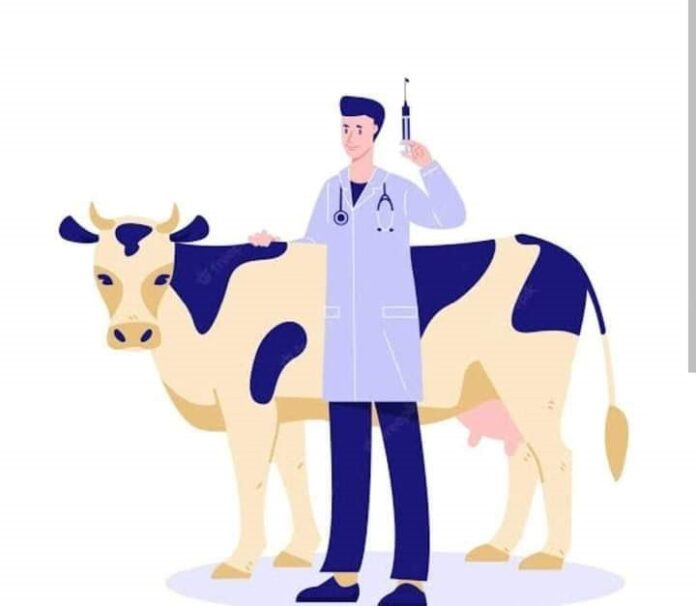Important Viral Diseases of Pigs and General Precautions for their Control and Prevention
COMMON DISEASES AND THEIR PREVENTION AND CONTROL MEASURE
Classical swine fever
Classical swine fever (CSF) is a contagious viral disease of pigs. CSF is caused by a virus belonging to the family Flaviviridae and the genus pestivirus.
SYMPTOMS
- Acute infection
- In acute form the pigs appear sick, inactive and drowsy with arched back. Some pigs stand with droopy head and straight tail. Huddling, vomiting, high fever anorexia and constipation. Conjunctivitis, staggering gait, posterior weakness and purple discoloration of abdominal skin
- In last stage of the infection, pigs will become recumbent, and convulsions may occur shortly before death. Sever diarrhoea will also occur during last stages.
- Chronic form
- Dullness, capricious appetite, pyrexia and diarrhoea for up to 1 month. Weight loss, hair loss, dermatitis and discoloration of abdomen or ears are the other symptoms. A chronically infected pig may have a disproportionately large head relative to the small trunk.
Diagnosis
- Based on high morbidity and mortality, high fever, diarrhoea. Kidney and lymph node lesions will help in field diagnosis.
VACCINATION
- Modified live vaccines (MLV) are used to control CSF.
SWINE INFLUENZA
- Swine influenza is a highly contagious respiratory viral infection of pigs caused by swine influenza vius, characterized by coughing, sneezing, nasal discharge, elevated rectal temperatures, lethargy, difficult breathing, depressed appetite and rarely associated with reproductive disorders such as abortion.
- The first clinical signs are fever (40.5-41.5ºC), puffy eyes, anorexia leading to loss of weight, depression, prostration and huddling leading to weakness. These signs are followed by sudden onset of acute respiratory signs, which include paroxysmal coughing, sneezing, irregular abdominal breathing and ocular and nasal discharges.
- In breeding stock, abortions, infertility, production of small weak litters and increased stillbirths.
PREVENTION AND COTROL
Good husbandry practices including All-in/All-out to limit the spread of the disease, provision of fresh clean drinking water, avoiding ducks and turkey contamination’s/contact including staff and proper use of disinfectants to clean infected buildings.
FOOT AND MOUTH DISEASE
Viral disease of pigs caused by FMD virus of the genus Aphthovirus. Characterized by fever (40-40.6ºC), anorexia, reluctance to move, and scream when forced to move. These signs are followed by vesicles on the coronary band, heals, inter digital space and on the snout. Mouth lesions are not too common and when they occur are smaller and of shorter duration than in cattle and tend to be a “dry”-type lesion. There is no drooling. Sows may abort. Piglets may die without showing any clinical sign.
DIAGNOSIS
- Based on symptom and lesions
Control and eradication program
- Prevention of movement of animals and animal products in the area affected.
- Destroy carcasses
- Disinfect vehicles leaving the infected area.
- Perform vaccination.
SWINE ERYSEPLAS
- A bacterial disease caused by Erysipelothrix rhusiopathiae.
Symptoms
- Erysipelas occurs in pigs of all ages, but pigs from 2 months to one year age are highly susceptible.
Acute
- The acute disease is characterized by high fever, in appetence, depression, a rapid course of illness, and death within 2-3 days in untreated animals.
- Some animals may show a stiff gait and reluctance to stand or move, and urticarial cutaneous lesions may develop.
- The diamond shaped raised skin lesions are pathognomonic. Pregnant sows may abort.
Chronic
- In the chronic form arthritis is more common.
- The hock, stifle, elbow and carpal joints are most likely to be affected resulting in severe lameness.The mitral valves are involved in valvular endocarditis. Diamond shaped skin lesions are pathognomonic.
Diagnosis can be achieved by
- Based on symptom and lesions
- Gram-positive rods in acute cases and Gram-positive filaments in chronic cases. Treatment
- In addition to hyper immune serum, treatment with antibiotics such as penicillin and tetracyclines are effective.
PIGLET MORTALITY
The major task in pig husbandry is avoiding piglet mortality and raising piglets successfully up to weaning. After weaning the mortality is comparatively less Pre-partum death may be due to deficiency of iron, which can be prevented by injection of sow with iron. Intrapartum death is due to anoxia induced by lack of placental blood flow associated with uterine contraction or premature rupture of umbilical card. This intra-partum death occurs mostly in aged sows.
Pre-weaning mortality
The pre-weaning mortality ranges between 12-30%.
Causes of mortality
| Sl. No | Reasons | % |
| 1 | Still birth | 17.4 |
| 2 | Eaten by the sow | 0.50 |
| 3 | Genetic defect | 1.60 |
| 4 | Over laid (crushing by mother) | 66.30 |
| 5 | Enteritis | 2.20 |
| 6 | Pneumonia | 0.50 |
| 7 | Unknown | 11.50 |
Starvation and overlying by the pig
70% of death is due to starvation and overlying by the sow, which can be avoided by
- Improving birth weight and vigor of newborn piglets
- Minimizing risk of chilling or hypothermia
- Minimizing agalactia
It is a part of complex condition of MMA (M= mastitis, M= metritis & A=agalactia). The MMA syndrome can involve metabolic, bacterial and hormonal factor with stress plays a part. Since its main effect is loss of milk in the first three days after farrowing, the condition contributes to piglet loss from starvation.
Reason and control of MMA
- Elevated temperature of sow is associated with this condition, hence regular monitoring of sows rectal temperature and treatment with antibiotic and oxytocin is essential to avoid this condition. Such conditions which are not detected earlier, it can be noticed by loss of body condition of piglets and it is very difficult to recover the condition quickly. In refractory case prompt provision of an alternative source of food for piglet by foster sow or artificial feeding will minimize the loss
- The udder and teat of sow should be dry and kept hygiene to avoid such problem
Piglet anemia
The newborn piglet has only limited reserve of iron in the liver for hemoglobin synthesis. This is due to poor placental transfer of iron to foetus. The sow milk is very low in iron and the suckling pig should be supplemented with iron during first few days to prevent piglet anaemia.
Symptom
- Pale in the region of ears and belly
- Listlessness
- Rapid breathing
- Often exhibit diarrhea
Control
- Placing fresh, clean earth in the piglets pen each day
- Using soil drenched with a solution made from 500 gm ferrous sulphate, 75 gm copper sulphate and 3 litter of water
- Daily administration of 4 ml of 1.8 percent ferrous sulphate solution
- The daily painting of the mother’s udder with ferrous sulphate solution and sugar [0.5 kg of ferrous sulphate in 10 liter of water]
- All these methods are labour intensive and the safest and easiest method of combating piglet anaemia is to inject the piglet with 100-150 mg of iron in the form of iron dextron 3 days after birth. If necessary a second and slightly smaller injection can be made some 3 weeks later
Compiled & Shared by- This paper is a compilation of groupwork provided by the
Team, LITD (Livestock Institute of Training & Development)
Image-Courtesy-Google
Reference-On Request.
Important Viral Diseases of Pigs and General Precautions for their Control and Prevention
An insight into classical swine fever
Biosecurity guidelines for piggery
Important Viral Diseases of Pigs and General Precautions for their Control and Prevention
An insight in classical swine fever
Biosecurity guidelines for piggery




